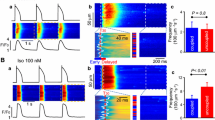Abstract Background:
Altered Ca2+ metabolism of the sarcoplasmic reticulum results in changes of the contractile behavior in failing human myocardium. The ryanodine-sensitive Ca2+ release channel of the sarcoplasmic reticulum plays a key role in the intracellular Ca2+ handling in cardiac myocytes. Recently, we showed that the density of 3H-ryanodine binding sites which correspond to the SR Ca2+ release channel in human myocardial homogenates is unchanged in failing human myocardium. However, the sensitivity of the channel towards Ca2+, which acts as the trigger signal of channel activation and thereby initiates contraction, has not yet been investigated in failing and nonfailing myocardium.
Methods: Homogenates (100 μg protein) from hearts with dilated (DCM, n = 10) or ischemic (ICM, n = 9) cardiomyopathy were incubated with a saturating concentration of 3H-ryanodine (12 nM) in the presence of different Ca2+ concentrations ranging from 1 nM to 10 mM. For comparison, myocardium of 8 nonfailing hearts which could not be transplanted for technical reasons was investigated. Nonspecific binding was determined in the presence of a high concentration (10 μM) of unlabeled ryanodine. Results: 3H-ryanodine binding to the Ca2+ release channel showed a bell-shaped pattern with an increase in specific binding at submicromolar Ca2+ concentrations and a decrease at higher Ca2+ concentrations than 0.5 mM, whereas nonspecific binding was not influenced by different Ca2+ concentrations. In nonfailing myocardium, maximal 3H-ryanodine binding (Bmax) was 85.2 ± 3.1 fmol/mg protein and half-maximal binding was reached at a free Ca2+ concentration of 0.25 (0.22 – 0.30)μM (EC50). Neither EC50 values nor maximal specific 3H-ryanodine binding differed between nonfailing and failing myocardium of both etiologies. EC50 values were 0.24 (0.23 – 0.26)μM (DCM, n = 10) or 0.28 (0.25 – 0.31)μM (ICM, n = 9), respectively. Caffeine (2 mM) and the ATP-analogon AMP-PCP (1 mM) led to a shift towards lower Ca2+ concentrations consistent with an activation of the channel by these compounds, whereas Mg2+ (0.7 mM) shifted the Ca2+-dependence of 3H-ryanodine binding towards higher Ca2+ concentrations indicating inhibition of channel opening. After activation of the Ca2+ release channel by caffeine or AMP-PCP as well as after the inhibition with MG2+ EC50 values were the same in failing and nonfailing myocardium.
Conclusion: Caffeine and AMP-PCP sensitize, whereas Mg2+ desensitizes the myocardial Ca2+ release channel to Ca2+. The determination of Ca2+-dependent 3H-ryanodine binding to the human myocardial Ca2+ release channel is a useful tool to investigate its open probability. Furthermore, the Ca2+-sensitivity and the pharmacological behavior of the human SR Ca2+ release channel are similar in failing and nonfailing myocardium.
Similar content being viewed by others
Author information
Authors and Affiliations
Additional information
Received: 7 October 1997, Returned for revision: 9 December 1997, 1.Revision received: 1 December 1998, Accepted: 5 January 1999
Rights and permissions
About this article
Cite this article
Schotten, U., Schumacher, C., Conrads, V. et al. Calcium-sensitivity of the SR calcium release channel in failing and nonfailing human myocardium. Basic Res Cardiol 94, 145–151 (1999). https://doi.org/10.1007/s003950050137
Issue Date:
DOI: https://doi.org/10.1007/s003950050137




